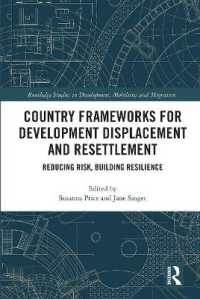- ホーム
- > 洋書
- > 英文書
- > Nature / Ecology
Full Description
The size and composition of primate groups varies tremendously across species, within species, and within groups over time. The most variable quantity is the number of adult males. In some groups, single males can monopolize access to several females, whereas reproduction is shared among several males in other groups. This variation lies at the heart of understanding adaptive variation among social systems. Whether groups contain single or multiple males has important consequences for reproductive strategies of both sexes, and also shapes these animals' morphology and behaviour. Written by leading authorities, this book provides an extensive overview of variation in group composition across all major primate taxa, using up-to-date reviews, case studies, evolutionary theory and theoretical models, setting primates into context with birds and other mammals. It will become a firm favorite with all those interested in the behavioural ecology of primates.
Contents
Preface; Part I. Introduction: 1. The socioecology of primate males: history and theory Peter M. Kappeler; Part II. Comparative Perspectives on Male-Female Association: 2. Multi-male breeding groups in birds: ecological causes and social conflicts Nick B. Davies; 3. Males in macropod society Peter Jarman; 4. Social counterstrategies against infanticide by males in primates and other mammals Carel van Schaik; Part III. Variation in Male Numbers: Taxon-Level Analyses: 5. Causes and consequences of unusual sex ratios in lemurs Peter M. Kappeler; 6. The number of adult males in callitrichine groups and its implications for callitrichine social evolution Eckhard W. Heymann; 7. From binding brotherhoods to short-term sovereignty: the betwixting dilemma of male Cebidae Karen B. Strier; 8. The number of males in guenon groups Marina Cords; 9. Socioecology of baboons: the interaction of male and female strategies Robert A. Barton; 10. Variation in adult sex ratios of red colobus monkey social groups: implications for interspecific comparisons Thomas T. Struhsaker; 11. The number of males in langur groups: monopolizability of females or demographic process? Elisabeth H. M. Sterck and Jan A. R. A. M. van Hooff; 12. Costs and benefits of the one-male, age-graded and all-male phase in wild Thomas langur groups Romy Steenbeek, Elisabeth H. M. Sterck, Han de Vries and Jan A. R. A. M. van Hooff; 13. Male dispersal and mating season influxes in Hanuman langurs living in multi-male groups Carola Borries; 14. Rethinking monogamy: the gibbon case Volker Sommer and Ulrich Reichard; 15. Causes and consequences of variation in male mountain gorilla life histories and group membership David P. Watts; Part IV. Behavioural Aspects of Male Coexistence: 16. Relationships among nonhuman primate males: a deductive framework Jan A. R. A. M. van Hooff; 17. Collective benefits, free-riders and male extragroup conflict Charles L. Nunn; 18. Dominance, egalitarianism and stalemate: an experimental approach to male-male competition in Barbary macaques Signe Preuschoft and Andreas Paul; Part V. Evolutionary Determinants and Consequences: 19. The evolution of male philopatry in neotropical monkeys Theresa Pope; 20. Models of outcome and process: predicting the number of males in primate groups Jeanne Altmann; 21. Why are male chimpanzees more gregarious than mothers? A scramble competition hypothesis Richard W. Wrangham; 22. Male mating strategies: a modeling approach Robin I. M. Dunbar; Part VI. Conclusions: 23. Understanding male primates Michael E. Pereira, Timothy H. Clutton-Brock and Peter M. Kappeler; References; Index.








